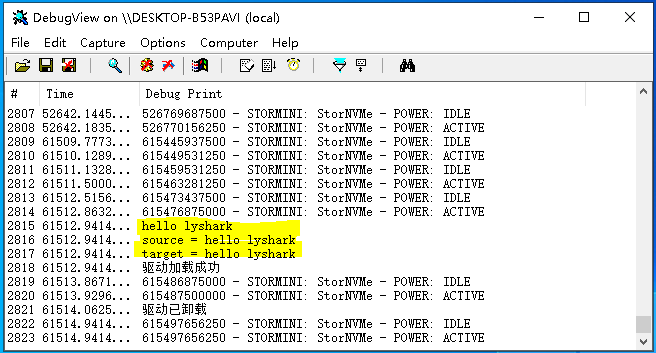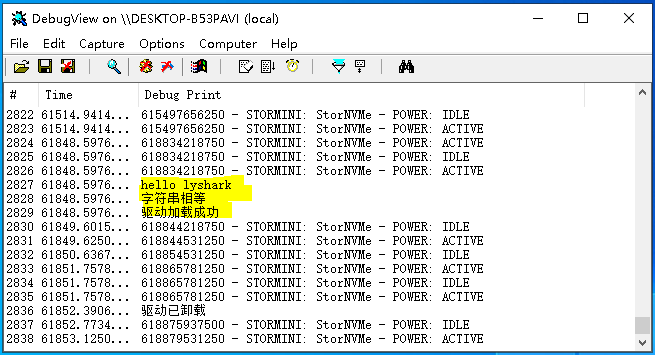在上一篇文章《内核字符串转换方法》中简单介绍了内核是如何使用字符串以及字符串之间的转换方法,本章将继续探索字符串的拷贝与比较,与应用层不同内核字符串拷贝与比较也需要使用内核专用的API函数,字符串的拷贝往往伴随有内核内存分配,我们将首先简单介绍内核如何分配堆空间,然后再以此为契机简介字符串的拷贝与比较。
首先内核中的堆栈分配可以使用ExAllocatePool()这个内核函数实现,此外还可以使用ExAllocatePoolWithTag()函数,两者的区别是,第一个函数可以直接分配内存,第二个函数在分配时需要指定一个标签,此外内核属性常用的有两种NonPagedPool用于分配非分页内存,而PagePool则用于分配分页内存,在开发中推荐使用非分页内存,因为分页内存数量有限。
内存分配使用ExAllocatePool函数,内存拷贝可使用RtlCopyMemory函数,需要注意该函数其实是对Memcpy函数的包装。
ExAllocatePool用于在内核空间分配内存。它的作用是向系统申请一块指定大小的内存,并返回这块内存的起始地址,供内核使用。需要注意的是,使用ExAllocatePool分配的内存是在内核空间中,因此不能被用户空间的代码直接访问。
RtlCopyMemory也是Windows内核开发中的一个函数,用于在内存中拷贝数据。它的作用是将指定长度的数据从源地址拷贝到目标地址,可以用于在内核空间中拷贝数据。需要注意的是,RtlCopyMemory实际上是对memcpy函数的封装,但是它提供了更加严格的参数检查和更好的错误处理机制,因此在内核开发中建议使用RtlCopyMemory而不是直接使用memcpy。
在使用这两个函数时需要注意以下几点:
- ExAllocatePool分配的内存必须在使用完后及时释放,否则会导致内存泄漏。可以使用
ExFreePool函数来释放内存。
- ExAllocatePool分配的内存是非连续的,因此不能使用指针算术运算来访问内存块中的某个元素。如果需要在内存块中访问某个元素,可以使用数组下标的方式来访问。
- RtlCopyMemory函数需要确保源地址和目标地址所指向的内存块不会重叠,否则会导致数据的不确定性。可以使用
RtlMoveMemory函数来处理源地址和目标地址重叠的情况。
#include <ntifs.h>
VOID UnDriver(PDRIVER_OBJECT driver)
{
DbgPrint("驱动已卸载 \n");
}
NTSTATUS DriverEntry(IN PDRIVER_OBJECT Driver, PUNICODE_STRING RegistryPath)
{
UNICODE_STRING uncode_buffer = { 0 };
DbgPrint("hello lyshark \n");
wchar_t * wchar_string = L"hello lyshark";
uncode_buffer.MaximumLength = 1024;
uncode_buffer.Buffer = (PWSTR)ExAllocatePool(PagedPool, 1024);
uncode_buffer.Length = wcslen(wchar_string) * 2;
ASSERT(uncode_buffer.MaximumLength >= uncode_buffer.Length);
RtlCopyMemory(uncode_buffer.Buffer, wchar_string, uncode_buffer.Length);
uncode_buffer.Length = wcslen(wchar_string) * 2;
DbgPrint("输出字符串: %wZ \n", uncode_buffer);
ExFreePool(uncode_buffer.Buffer);
uncode_buffer.Buffer = NULL;
uncode_buffer.Length = uncode_buffer.MaximumLength = 0;
DbgPrint("驱动已加载 \n");
Driver->DriverUnload = UnDriver;
return STATUS_SUCCESS;
}
|
代码输出效果如下图所示:

实现空间分配,字符串结构UNICODE_STRING可以定义数组,空间的分配也可以循环进行,例如我们分配十个字符串结构,并输出结构内的参数。
#include <ntifs.h>
VOID UnDriver(PDRIVER_OBJECT driver)
{
DbgPrint("驱动已卸载 \n");
}
NTSTATUS DriverEntry(IN PDRIVER_OBJECT Driver, PUNICODE_STRING RegistryPath)
{
UNICODE_STRING uncode_buffer[10] = { 0 };
wchar_t * wchar_string = L"hello lyshark";
DbgPrint("hello lyshark \n");
int size = sizeof(uncode_buffer) / sizeof(uncode_buffer[0]);
DbgPrint("数组长度: %d \n", size);
for (int x = 0; x < size; x++)
{
uncode_buffer[x].Buffer = (PWSTR)ExAllocatePool(PagedPool, 1024);
uncode_buffer[x].MaximumLength = 1024;
uncode_buffer[x].Length = wcslen(wchar_string) * sizeof(WCHAR);
ASSERT(uncode_buffer[x].MaximumLength >= uncode_buffer[x].Length);
RtlCopyMemory(uncode_buffer[x].Buffer, wchar_string, uncode_buffer[x].Length);
uncode_buffer[x].Length = wcslen(wchar_string) * sizeof(WCHAR);
DbgPrint("循环: %d 输出字符串: %wZ \n", x, uncode_buffer[x]);
ExFreePool(uncode_buffer[x].Buffer);
uncode_buffer[x].Buffer = NULL;
uncode_buffer[x].Length = uncode_buffer[x].MaximumLength = 0;
}
DbgPrint("驱动加载成功 \n");
Driver->DriverUnload = UnDriver;
return STATUS_SUCCESS;
}
|
代码输出效果如下图所示:

实现字符串拷贝,此处可以直接使用RtlCopyMemory函数直接对内存操作,也可以调用内核提供的RtlCopyUnicodeString函数来实现,具体代码如下。
#include <ntifs.h>
VOID UnDriver(PDRIVER_OBJECT driver)
{
DbgPrint("驱动已卸载 \n");
}
NTSTATUS DriverEntry(IN PDRIVER_OBJECT Driver, PUNICODE_STRING RegistryPath)
{
DbgPrint("hello lyshark \n");
UNICODE_STRING uncode_buffer_source = { 0 };
UNICODE_STRING uncode_buffer_target = { 0 };
RtlInitUnicodeString(&uncode_buffer_source, L"hello lyshark");
uncode_buffer_target.Buffer = (PWSTR)ExAllocatePool(PagedPool, 1024);
uncode_buffer_target.MaximumLength = 1024;
RtlCopyUnicodeString(&uncode_buffer_target, &uncode_buffer_source);
DbgPrint("source = %wZ \n", &uncode_buffer_source);
DbgPrint("target = %wZ \n", &uncode_buffer_target);
RtlFreeUnicodeString(&uncode_buffer_target);
DbgPrint("驱动加载成功 \n");
Driver->DriverUnload = UnDriver;
return STATUS_SUCCESS;
}
|
代码输出效果如下图所示:

实现字符串比较,如果需要比较两个UNICODE_STRING字符串结构体是否相等,那么可以使用RtlEqualUnicodeString这个内核函数实现。
RtlEqualUnicodeString用于比较两个UNICODE_STRING字符串结构体是否相等。该函数的第一个参数是指向要比较的第一个字符串结构体的指针,第二个参数是指向要比较的第二个字符串结构体的指针,第三个参数是指定比较的方式,如果该参数为TRUE,则函数会在相等的情况下返回TRUE,否则会在不相等的情况下返回FALSE。
下面是一个使用RtlEqualUnicodeString函数比较两个字符串结构体是否相等的示例代码:
#include <ntifs.h>
VOID UnDriver(PDRIVER_OBJECT driver)
{
DbgPrint("驱动已卸载 \n");
}
NTSTATUS DriverEntry(IN PDRIVER_OBJECT Driver, PUNICODE_STRING RegistryPath)
{
DbgPrint("hello lyshark \n");
UNICODE_STRING uncode_buffer_source = { 0 };
UNICODE_STRING uncode_buffer_target = { 0 };
RtlInitUnicodeString(&uncode_buffer_source, L"hello lyshark");
RtlInitUnicodeString(&uncode_buffer_target, L"hello lyshark");
if (RtlEqualUnicodeString(&uncode_buffer_source, &uncode_buffer_target, TRUE))
{
DbgPrint("字符串相等 \n");
}
else
{
DbgPrint("字符串不相等 \n");
}
DbgPrint("驱动加载成功 \n");
Driver->DriverUnload = UnDriver;
return STATUS_SUCCESS;
}
|
代码输出效果如下图所示:

有时在字符串比较时需要统一字符串格式,例如将所有字符全部转换为大写之后再做比较,此时可以使用RtlUpcaseUnicodeString函数将小写字符串为大写。
RtlUpcaseUnicodeString用于将UNICODE_STRING字符串结构体中的字符转换为大写字符。该函数的第一个参数是指向要转换的字符串结构体的指针,第二个参数是指向要存储结果的字符串结构体的指针,第三个参数指定转换的方式。
下面是一个使用RtlUpcaseUnicodeString函数大小写字符串转换的示例代码:
#include <ntifs.h>
VOID UnDriver(PDRIVER_OBJECT driver)
{
DbgPrint("驱动已卸载 \n");
}
NTSTATUS DriverEntry(IN PDRIVER_OBJECT Driver, PUNICODE_STRING RegistryPath)
{
DbgPrint("hello lyshark \n");
UNICODE_STRING uncode_buffer_source = { 0 };
UNICODE_STRING uncode_buffer_target = { 0 };
RtlInitUnicodeString(&uncode_buffer_source, L"hello lyshark");
RtlInitUnicodeString(&uncode_buffer_target, L"HELLO LYSHARK");
RtlUpcaseUnicodeString(&uncode_buffer_target, &uncode_buffer_source, TRUE);
DbgPrint("小写输出: %wZ \n", &uncode_buffer_source);
DbgPrint("变大写输出: %wZ \n", &uncode_buffer_target);
RtlFreeUnicodeString(&uncode_buffer_target);
DbgPrint("驱动加载成功 \n");
Driver->DriverUnload = UnDriver;
return STATUS_SUCCESS;
}
|
代码输出效果如下图所示:





